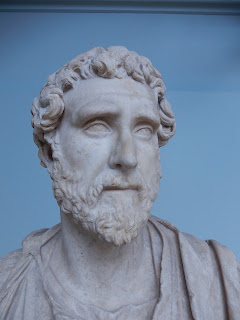Let’s talk about this guy:
 |
| Why couldn’t the Scots just behave themselves? |
This is Antoninus Pius, or Emperor Antoninus (138-161 CE), who was tired of the restless barbarians to the north, so he ordered a wall built. The Antonine Wall was a timber and turf fortification that ran east to west across the “neck” of Scotland, roughly from Glasgow to Edinburgh. Mind you, this was built AFTER Hadrian’s Wall (122-128 CE). Was the Antonine Wall really necessary? Well, like so many other Emperors, the great construction project was a “twofer” - first, invading Scotland early in his reign made sense since he was a bureaucrat and needed to show the army he could dish it out. So he did and ordered the soldiers in and they began building a wall in 142 CE. The second part of the twofer was to keep the army pressed against the edges of the Empire and away from Rome.
If you thought the Scots (Caledonians) were rough, there were revolts in Dacia, Syria, Mesopotamia, Egypt and the usual political intrigue and backstabbing in Rome. Antoninus needed to exert control and keep the army occupied. Sadly, the Antonine Wall was abandoned in 165 CE, as Roman forces pulled back to Hadrian’s Wall (soldiers were also needed to be dispatched to other parts of the Empire as a devastating plague wiped out tens of thousands of Roman soldiers).
Nevertheless this slab dedicates the construction of the Eastern Half of the Antonine Wall (and shows those wretched barbarians cowering in fear just before utter defeat). Ok, so they didn’t down quite that easily. In fact, you might say they became shrewd businessmen along the way. As the Empire fell apart, it became a more and more common practice to bribe your enemies. The Romans rewarded some tribes who pledged allegiance to them in silver and gold. Some tribes they paid the same silver and gold to so they wouldn’t attack.
This is the Falkirk Hoard:
Nearly 2,000 coins - most of them silver - were found in a clay vessel wrapped in what some claim was a tartan plaid pattern. The museum educator I spoke with said there was some debate in the archaeological community around this point, but most agreed that the Falkrick Hoard was a bribe - or the storage of multiple bribes over time. The coins range from 38 BCE to 230 CE (which was around one of the final Scottish campaigns by Rome).
It was interesting to learn just how much of a footprint Rome left in Scotland. Would I find similar stories along Hadrian’s Wall? What riches have been discovered there? I'm looking forward to my trip to Vindolanda to learn more!


No comments:
Post a Comment